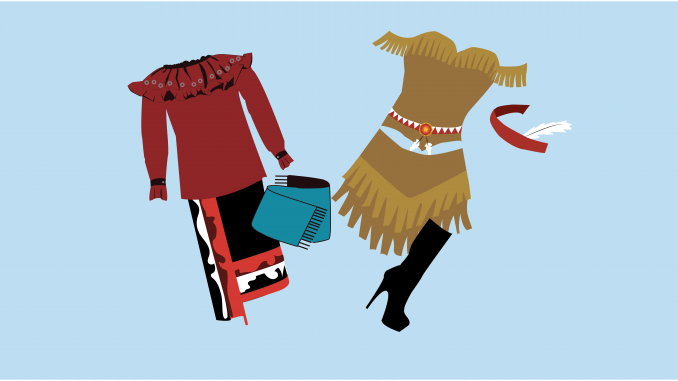
Ashton Dunkley is a member of the Nanticoke Lenni-Lenape, an indigenous tribe in Bridgeton, New Jersey. But that does not mean she wears feathers, leather or tribal beading on a daily basis.
“There’s still [Native] people today that don’t dress like that at all,” said Dunkley, a senior history and anthropology major. “I’m in jeans. I’m not wearing any leather. That’s not the image of native people that should be perpetuated.”
Dunkley, who also runs on the cross country team, said when outsiders clothe themselves in imitations of indigenous outfits for Halloween or music festivals, they both misrepresent her culture and undermine the historical significance behind traditional garb.
“It’s really demeaning to have your culture squished into this little box that really just includes feathers, fringe and plastic beads,” Dunkley said. “It’s weird being depicted, in terms of Halloween costumes, as a character instead of a people.”
But leading up to Halloween, stores and websites market indigenous cultures as just that — characters.
Many of these characters are hyper-sexualized indigenous women with names like “Sexy Native American” and “Pocahottie,” which can be bought from Amazon, Poshmark and other retailers. These costumes are controversial because of the high rates of sexual violence committed against indigenous women. More than 56 percent of American Indian or Alaska Native women experienced sexual violence in their lifetime, according to a 2016 study by the National Institute of Justice.
“Knowing that, and then having costumes that perpetuate sexual images and fetishize Indigenous women… they’re not indigenous with those costumes,” Dunkley said.
Yandy, an online Halloween costume merchant, has 44 Native American costumes and accessories. Yandy received backlash from both news outlets and social media for its lack of cultural respect, and protesters took to Twitter in September with the hashtag, #CancelYandy.
Adam DePaul, an English instructor and member of the Lenape Nation of Pennsylvania, said he is less concerned about cultural appropriation in relation to skimpy costumes or Halloween than he is when his culture is misrepresented at museums or formal events.
“There is an extent to which imitation is a sign of flattery,” DePaul said. “Children who want to dress up as Native Americans for Halloween are obviously interested in Native American culture.”
DePaul added he is speaking for himself and not for the entire Lenape Nation.
Still, some said because of the long history of oppression of Native Americans, no form of indigenous costume-wearing or cultural appropriation is ever acceptable.
“This is a population that we as Americans through our history actually pushed out of their land,” said Raquel Pérez, a doctoral student and a sociology teaching assistant. “We literally, not just figuratively, literally, robbed [them] of their cultural markers and their identity and their homes. To borrow from them and to play up stereotypes really downplays the reality of the plight that is still going on.”
Another problem is that outsiders may not be able to distinguish if they’re “borrowing” a culture, or simply making one up. Accessories like tribal headdresses, turquoise jewelry and white sage come predominantly from the natives in the Great Plains, not from the Lenape, DePaul said.
He added that the Lenape are known for wearing animal skins like deer, beaver and prairie dog as casual wear. For larger ceremonies, members dress in fur or elaborate beadwork.
“A lot of people don’t understand that there’s a very large difference between different clans,” DePaul said. “The Lenape aren’t the Iroquois, they aren’t the Mohican, we aren’t the Sioux. Every Native American tribe is as individual as a European country.”
Dunkley said she is unsure if a peer would know how to accurately represent her tribe through costume — though she added she prefers they not try.
Dunkley added that a key component to understanding the history of indigenous people is understanding their present. In a blog written for the American Philosophical Society this August, Dunkley referenced a 2015 study that found 87 percent of references to Native Americans in K-12 education standards in all 50 states are from a pre-1900 context. This could, in turn, influence the lack of empathy felt by outsiders appropriating Native American culture during Halloween.
“Native people, they’re still here, which I think people neglect or forget at some point,” Dunkley said. “They’re like, ‘Oh, it’s just an image, just a mascot, just a costume, just this, all the time.’ But after a while, all that kind of builds up and erases the fact that they’re still native people, here, seeing this.”



Thank you for addressing this issue. It is a valid concern and ongoing problem. Misrepresentation and misappropriation is wrong on all levels. We cannot accept one and allow others. Our young generation is our future. It starts with them. Dunkley is spot on and we must insist on accuracy and cultural sensitivity. We are still here need to command the same respect as any other human being.
Again, thank you for highlighting this issue
Best,
Denise Bright Dove
Nanticoke Lenni-Lenape